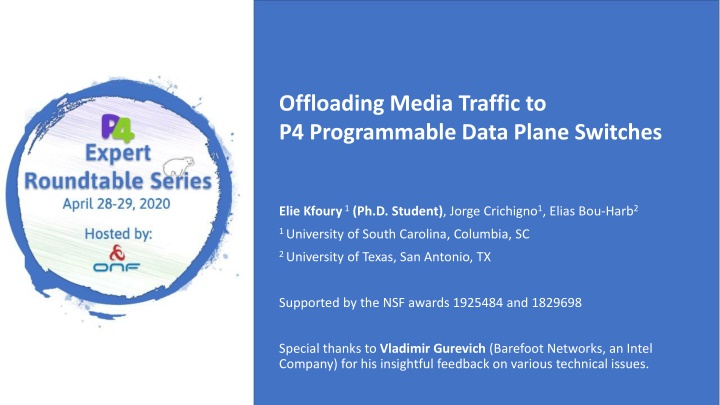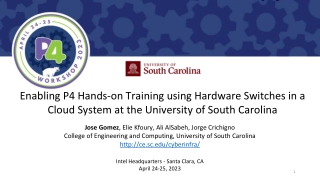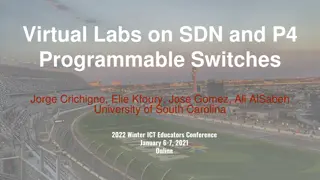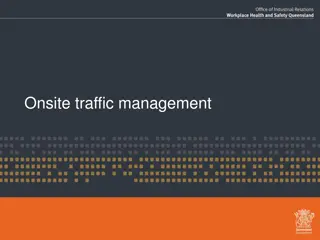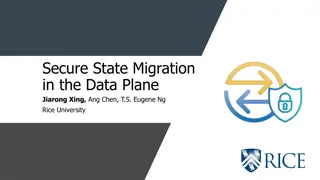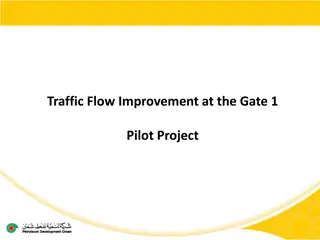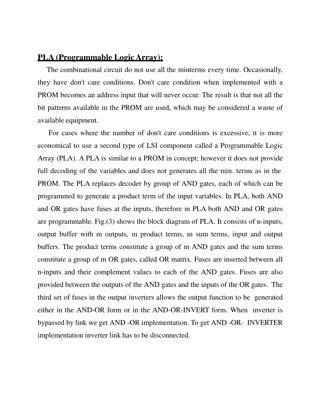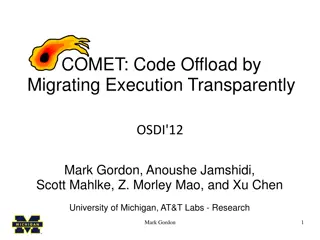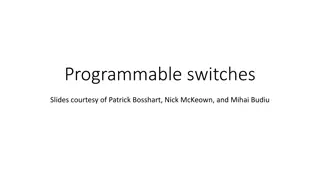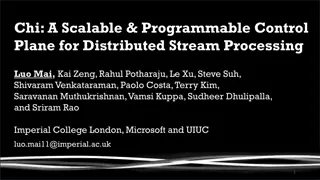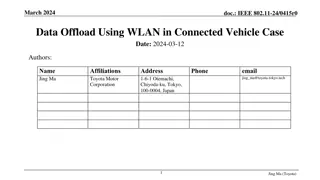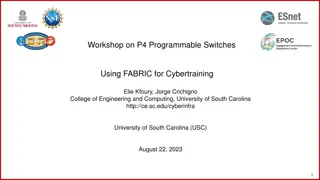Offloading Media Traffic to P4 Programmable Data Plane Switches
Media traffic constitutes a significant portion of internet data, with voice and video services becoming ubiquitous. This study explores offloading media traffic to P4 programmable data plane switches, addressing challenges such as SIP, RTP, NAT traversal, and proposed solutions.
Download Presentation

Please find below an Image/Link to download the presentation.
The content on the website is provided AS IS for your information and personal use only. It may not be sold, licensed, or shared on other websites without obtaining consent from the author.If you encounter any issues during the download, it is possible that the publisher has removed the file from their server.
You are allowed to download the files provided on this website for personal or commercial use, subject to the condition that they are used lawfully. All files are the property of their respective owners.
The content on the website is provided AS IS for your information and personal use only. It may not be sold, licensed, or shared on other websites without obtaining consent from the author.
E N D
Presentation Transcript
Offloading Media Traffic to P4 Programmable Data Plane Switches Elie Kfoury1(Ph.D. Student), Jorge Crichigno1, Elias Bou-Harb2 1 University of South Carolina, Columbia, SC 2 University of Texas, San Antonio, TX Supported by the NSF awards 1925484 and 1829698 Special thanks to Vladimir Gurevich (Barefoot Networks, an Intel Company) for his insightful feedback on various technical issues. 2/23/2025
Agenda Introduction Background Information Session Initiation Protocol (SIP) and Real Time Protocol (RTP) Network Address Translation (NAT) traversal problem P4 switches Proposed solution Evaluation Lessons learned 2 2/23/2025 Offloading Media Traffic to Programmable Data Plane Switches
Introduction According to estimations, media traffic represents approximately 80% of the total traffic over the Internet1 Much media traffic is generated by end users communicating with each other Media services (voice, video) running alongside the data network in campuses are becoming standard 1 H. W. Barz and G. A. Bassett, Multimedia networks: protocols, design and applications, John Wiley and Sons, 2016. 3 2/23/2025 Offloading Media Traffic to Programmable Data Plane Switches
Voice and Video Conversational Voice- and Video-over-IP are widely used today Open and proprietary solutions Supporting protocols are divided into two main categories Session control protocols (signaling): establish and manage the session E.g., Session Initiation Protocol (SIP) Media protocols (media) Transfer audio and video streams between the end-users E.g., Real Time Protocol (RTP) Desirable Quality-of-Service (QoS) characteristics Delay- and jitter-sensitive, low values Occasional losses are tolerated 4 2/23/2025 Offloading Media Traffic to Programmable Data Plane Switches
Signaling and Media Protocols SIP initiates, maintains, and terminates multimedia sessions between endpoints User agent client (UAC) User agent server (UAC) RTP transports real-time data, such as audio and video SIP server, registrar SIP SIP Media (RTP) UAC UAS 5 2/23/2025 Offloading Media Traffic to Programmable Data Plane Switches
Network Address Translation (NAT) NAT maps ports, private IP addresses to public IP addresses Used in campus / enterprise networks, operators1 NAT introduces various issues Violation of the end-to-end principle Traversal of end-to-end sessions Source = 128.143.71.21 Source port = 3200 Source = 10.0.1.2 Source port = 2001 Private address: 10.0.1.2 128.143.71.21 NAT H1 Internet Private network Private address: 10.0.1.3 Source = 128.143.71.21 Destination = 4444 H2 Source = 10.0.1.3 Source port = 1090 1 I. Livadariu et al., Inferring carrier-grade NAT deployment in the wild, in IEEE 2018 INFOCOM, 2018. 6 2/23/2025 Offloading Media Traffic to Programmable Data Plane Switches
Network Address Translation (NAT) NAT prevents a user from outside from initiating a session If both users have NATs, then neither can accept a call IP translation is recorded by a SIP registrar server SIP carries the IP addresses and ports to be used by RTP to send/receive media Ports are unknown until RTP traffic starts Several solutions proposed for NAT traversal STUN - RFC 53891, TURN - RFC 75662, ICE - RFC 84453 1 D. Wing, P. Matthews, R. Mahy, and J. Rosenberg, RFC 5389 - STUN: Session traversal utilities for NAT, 2008. 2 M. Petit-Huguenin, S. Nandakumar, G. Salgueiro, and P. Jones, RFC 7566 - TURN: Traversal using relays around NAT (TURN) uniform resource identifiers, 2013. 3 J. Rosenberg and C. Holmberg, RFC 8445 - ICE: Interactive connectivity establishment: a protocol for Network Address Translator (NAT) traversal, 2018. 7 2/23/2025 Offloading Media Traffic to Programmable Data Plane Switches
Relay Server for Media Traffic Intermediary device RTP Information at relay server SIP server Relay server Device IP - port Allocated IP - port A B A B 8 2/23/2025 Offloading Media Traffic to Programmable Data Plane Switches
Relay Server for Media Traffic Intermediary device SIP establishes the session RTP ports are unknown RTP Information at relay server SIP server Relay server The relay server allocates a port on behalf of each end user Device IP - port Allocated IP - port IPR - PRA A B IPR - PRB A B 9 2/23/2025 Offloading Media Traffic to Programmable Data Plane Switches
Relay Server for Media Traffic Intermediary device SIP establishes the session RTP ports are unknown RTP Information at relay server SIP server Relay server The relay server allocates a port on behalf of each end user Device IP - port IPA - PA Allocated IP - port IPR - PRA A The relay server receives and relays the RTP traffic B IPB - PB IPR - PRB IPA - pA IPB - pB A B 10 2/23/2025 Offloading Media Traffic to Programmable Data Plane Switches
Relay Server for Media Traffic Intermediary device SIP establishes the session RTP ports are unknown RTP Information at relay server SIP server Relay server The relay server allocates a port on behalf of each end user Device IP - port IPA - PA Allocated IP - port IPR - PRA A The relay server receives and relays the RTP traffic B IPB - PB IPR - PRB IPA - pA IPB - pB A B 11 2/23/2025 Offloading Media Traffic to Programmable Data Plane Switches
Overview P4 Switches P4 switches permit programmer to program the data plane Add proprietary features; e.g., emulate RTP relay server Parse packet headers, including UDP packets carrying RTP traffic Header inspection, identifying media sessions using the 5-tuple Modify fields, IP addresses and ports If the P4 program compiles, it runs on the chip at line rate Programmable chip P4 code 12 2/23/2025 Offloading Media Traffic to Programmable Data Plane Switches
Proposed System Emulate the behavior of the relay server using programmable switch: 1. Parse the incoming packet carrying media traffic from the first party, say user A 2. Identify the session this packet belongs to by using the 5-tuple 3. Replace the source IP with that of the relay server, and the source port with that used by the relay server to receive traffic from user A 4. Replace the destination IP and the destination port with those of user B 5. Recalculate both IPv4 and UDP checksums 6. Forward the packet to user B 13 2/23/2025 Offloading Media Traffic to Programmable Data Plane Switches
Proposed System A custom software (agent) learns the ports allocated to a media session by the relay server The Rule Generator uses the 5-tuple allocated to the media session to construct a unique session identifier It stores identifiers of the media sessions and the new header values in the switch It also clears media sessions allocated in the switch when a call is teared down Allocations exchange (UDP) Agent SIP server Relay server Rule Generator Rules Manager Add/Del Programmable switch SIP BYE 14 2/23/2025 Offloading Media Traffic to Programmable Data Plane Switches
Implementation and Evaluation OpenSIPS, an open source implementation of a SIP server RTPProxy, a high-performance relay server for RTP streams SIPp: an open source SIP traffic generator that can establish multiple concurrent sessions and generate media (RTP) traffic Iperf3: traffic generator used to generate background UDP traffic Edgecore Wedge100BF-32X: programmable switch SIP server Edgecore w/ Tofino Chip 40Gbps UDP Mgmt port 40Gbps SIPp (UAC) Intel Xeon 4 cores, 2.20GHz TCP Agent Intel Xeon 4 cores, 2.20GHz 40Gbps Programmable switch 40Gbps SIPp (UAS) Relay server 15 2/23/2025 Offloading Media Traffic to Programmable Data Plane Switches
Implementation and Evaluation Two scenarios are considered: Server-based relay : relay server is used to relay media between end devices, without the intervention of the switch Switch-based relay : the switch is used to relay media UAC (SIPp) generates 900 media sessions, 30 per second The test lasts for 300 seconds G.711 media encoding codec (160 bytes every 20ms) Switch-based relay Server-based relay UAC UAS Programmable Switch Relay server 16 2/23/2025 Offloading Media Traffic to Programmable Data Plane Switches
Results Delay: time interval starting when a packet is received from the UAC by the switch s ingress port and ending when the packet is forwarded by the switch s egress port to the UAS Delay contributions of the switch and the relay server 17 2/23/2025 Offloading Media Traffic to Programmable Data Plane Switches
Results Delay variation: the absolute value of the difference between the delay of two consecutive packets Analogous to jitter, as defined by RFC 4689 18 2/23/2025 Offloading Media Traffic to Programmable Data Plane Switches
Results Loss rate: number of packets that fail to reach the destination Calculation is based on the sequence number of the RTP header 19 2/23/2025 Offloading Media Traffic to Programmable Data Plane Switches
Results Mean Opinion Score (MOS): estimation of the quality of the media session A reference quality indicator standardized by ITU-T Maximum for G.711 is ~4.4 20 2/23/2025 Offloading Media Traffic to Programmable Data Plane Switches
Results CPU usage: the percentage of the CPU s capacity used by the relay server 21 2/23/2025 Offloading Media Traffic to Programmable Data Plane Switches
Resource Consumption The prototype is implemented in two different scenarios: On top of the baseline switch program (switch.p4): implements various features including Layer 2/3 functionalities, ACL, QoS, etc. Standalone implementation Additional hardware resources used when the solution is deployed on top of switch.p4 and as a standalone program 22 2/23/2025 Offloading Media Traffic to Programmable Data Plane Switches
Lessons Learned Advantages of using a switch-based relay: Performance: ~1,000,000 sessions vs ~1,000 sessions per core Optimal QoS parameters: delay, delay variation, packet loss rate Flexibility: switch permits to modify / forward packets using non-standard fields Precise timing information: measuring delay and its variation on the P4 switch results in precise high-resolution timing information Programmer can free unused resources and customize program: accommodate additional sessions Limited resources Avoid complex application logic 23 2/23/2025 Offloading Media Traffic to Programmable Data Plane Switches
Acknowledgement Thanks to the National Science Foundation (NSF)! Activities in the CI Lab at the UofSC are supported by NSF, Office of Advanced Cyberinfrastructure (OAC), awards 1925484 and 1829698 24 2/23/2025 Offloading Media Traffic to Programmable Data Plane Switches
Thank You Contact info for further questions Full text ekfoury@email.sc.edu jcrichigno@cec.sc.edu CI Lab website https://tinyurl.com/wab7yej http://ce.sc.edu/cyberinfra/ 25 2/23/2025 Offloading Media Traffic to Programmable Data Plane Switches
